Adaptive Context-Aware VANET Routing Protocol for Intelligent Transportation Systems
Abstract
1. Introduction
1.1. Challenges in VANET Routing
- High Mobility: The constant motion of vehicles leads to rapid and unpredictable topology variations, which often cause route disruptions and lower packet delivery rates [4].
- Dynamic Network Topology: Because the network structure changes continuously, routing algorithms must be capable of quick reconfiguration while maintaining reliable performance [5].
- Traffic Density Variation: The contrast between congested urban areas and sparsely populated highways produces inconsistent link availability, resulting in unstable communication patterns [6].
- Scalability Requirements: As vehicular networks expand, protocols must scale effectively without adding excessive routing overhead [7].
- Safety and Real-Time Demands: Safety-focused applications require near-instantaneous message delivery, making latency reduction essential [8].
1.2. Existing VANET Routing Protocols
1.3. Motivation and Research Gap
- Existing protocols often fail in high-mobility urban environments, leading to broken routes and dropped packets.
- Most solutions do not adapt dynamically to vehicle density or mobility patterns, resulting in suboptimal performance.
- Scalability remains a concern, especially for large-scale networks with heterogeneous vehicle types.
- Integration of context-awareness, clustering, and geographic strategies is limited in current research.
1.4. Proposed Solution Overview
- Dynamically adapt routing decisions based on vehicle density, mobility, and road topology.
- Minimize routing overhead while ensuring high packet delivery ratio and low end-to-end delay.
- Integrate clustering mechanisms with geographic positioning to enhance scalability and reliability.
1.5. Organization of the Paper
- Section 2 presents a detailed survey of existing VANET routing protocols and identifies research gaps.
- Section 3 introduces the proposed ACAVR protocol, including the network model, protocol flow, and mathematical formulations.
- Section 4 presents simulation results and performance comparisons with existing protocols.
- Section 5 concludes the paper and outlines directions for future research.
2. Related Work
3. Methodology
3.1. Network Model
3.2. Protocol Architecture
- Context-Aware Routing Module: Analyzes instantaneous vehicle parameters such as mobility, neighborhood density, and surrounding road layout to determine optimal relay paths.
- Dynamic Clustering Module: Organizes vehicles into short-lived clusters, thereby lowering routing overhead and improving scalability. Each cluster designates a Cluster Head (CH) by evaluating metrics like link stability, speed uniformity, and relative position.
- Geographic Forwarding Module: Utilizes GPS coordinates to transmit packets toward the intended destination while minimizing unnecessary detours or congestion points.
3.3. Cluster Formation and Maintenance
- -
- = instantaneous speed of the vehicle (lower speed signifies better stability for CH candidacy)
- -
- = node connectivity, representing the number of nearby neighbors
- -
- = distance between the vehicle and the cluster’s geometric center
- -
- = tuning coefficients that fulfill
3.4. Routing Algorithm
- Context Evaluation: Each node determines a Context Score (CS) using the density of neighboring vehicles, velocity characteristics, and the type of road segment:Here, is the local vehicle density, denotes relative speed, and represents the road-type factor. The coefficients , , and are adjustable to align with environmental conditions. To minimize frequent re-elections, each CH maintains a stability index that records its velocity variance and history of link breaks. When this stability metric drops below a set limit, a new CH is selected, effectively reducing unnecessary control traffic and maintaining steady cluster organization.
- Packet Forwarding Decision: Packets are forwarded to the neighbor with the highest CS, ensuring progress towards the destination while maintaining link stability.
- Cluster-Assisted Routing: Inter-cluster routing is performed via CHs, reducing the number of hops and control overhead. Intra-cluster packets are broadcast efficiently within the cluster.
| Algorithm 1: ACAVR Routing Algorithm Pseudo-Code. |
Input: Source node S, Destination node D, Vehicle set V, RSU set R Output: Forwarding path from S to D 1: Initialize clusters using weighted metric for each vehicle 2: For each cluster, elect Cluster Head (CH) 3: While S has packets to send: 4: Evaluate Context Score (CS) for all neighbors 5: Select neighbor with highest CS as next hop 6: If next hop is CH, forward packet to CH for inter-cluster routing 7: Else, forward packet directly to next hop 8: Update cluster membership every seconds 9: End While |
4. Results and Discussion
4.1. Simulation Setup
4.2. Performance Metrics
- Throughput (Mbps): Amount of data successfully delivered per unit time.
- Packet Delivery Ratio (PDR): Ratio of packets received to packets sent.
- End-to-End Delay (ms): Average time taken for a packet to reach the destination.
- Routing Overhead (%): Ratio of control packets to data packets.
4.3. Throughput Analysis
4.4. Packet Delivery Ratio (PDR)
4.5. End-to-End Delay
4.6. Routing Overhead
4.7. Overall Performance Comparison
4.8. Scalability Analysis
4.9. Summary of Results
5. Conclusions
Author Contributions
Funding
Data Availability Statement
Acknowledgments
Conflicts of Interest
Abbreviations
| ACAVR | Adaptive Context-Aware VANET Routing |
| AODV | Ad hoc On-Demand Distance Vector |
| CAEL | Compacted Area with Effective Links |
| CH | Cluster Head |
| ComS | Composite Score |
| CS | Context Score |
| DSR | Dynamic Source Routing |
| DSRC | Dedicated Short-Range Communication |
| DyTE | Dynamic Trilateral Enrolment |
| E2E | End-to-End |
| GPCR | Greedy Perimeter Coordinator Routing |
| GPS | Global Positioning System |
| GPSR | Greedy Perimeter Stateless Routing |
| ITS | Intelligent Transportation Systems |
| MANET | Mobile Ad Hoc Network |
| MEC | Multi-access Edge Computing |
| NS-2 | Network Simulator version 2 |
| OLSR | Optimized Link State Routing |
| PDR | Packet Delivery Ratio |
| RGoV | Reliable Group of Vehicles |
| RSU | Roadside Unit |
| SDN | Software Defined Network |
| SUMO | Simulation of Urban Mobility |
| V2I | Vehicle-to-Infrastructure |
| V2V | Vehicle-to-Vehicle |
| VANET | Vehicular Ad Hoc Network |
References
- Hartenstein, H.; Laberteaux, L. A tutorial survey on vehicular ad hoc networks. IEEE Commun. Mag. 2008, 46, 164–171. [Google Scholar] [CrossRef]
- Olariu, S.; Weigle, M.C. Vehicular Networks: From Theory to Practice; Chapman and Hall/CRC: Boca Raton, FL, USA, 2009. [Google Scholar]
- Chatterjee, T.; Karmakar, R.; Kaddoum, G.; Chattopadhyay, S.; Chakraborty, S. A survey of VANET/V2X routing from the perspective of non-learning-and learning-based approaches. IEEE Access 2022, 10, 23022–23050. [Google Scholar] [CrossRef]
- Kazi, A.K.; Khan, S.M. Working of various routing protocols in Vehicular Ad-hoc Network: A Survey. Univ. Sindh J. Inf. Commun. Technol. 2020, 4, 278–286. [Google Scholar]
- Waqas, M.; Niu, Y.; Li, Y.; Ahmed, M.; Jin, D.; Chen, S.; Han, Z. A comprehensive survey on mobility-aware D2D communications: Principles, practice and challenges. IEEE Commun. Surv. Tutor. 2019, 22, 1863–1886. [Google Scholar] [CrossRef]
- Lochert, C.; Hartenstein, H.; Tian, J.; Fussler, H.; Hermann, D.; Mauve, M. A Routing Strategy for Vehicular Ad Hoc Networks in City Environments. In Proceedings of the IEEE IV 2003 Intelligent Vehicles Symposium, Columbus, OH, USA, 9–11 June 2003; Proceedings (Cat. No. 03TH8683). IEEE: New York, NY, USA, 2003; pp. 156–161. [Google Scholar]
- Belamri, F.; Boulfekhar, S.; Aissani, D. A survey on QoS routing protocols in Vehicular Ad Hoc Network (VANET). Telecommun. Syst. 2021, 78, 117–153. [Google Scholar] [CrossRef]
- Abbas, F.; Fan, P.; Khan, Z. A novel low-latency V2V resource allocation scheme based on cellular V2X communications. IEEE Trans. Intell. Transp. Syst. 2018, 20, 2185–2197. [Google Scholar] [CrossRef]
- Perkins, C.; Belding-Royer, E.; Das, S. Ad Hoc on-Demand Distance Vector (AODV) Routing. In Proceedings of the WMCSA’99, Second IEEE Workshop on Mobile Computing Systems and Applications, New Orleans, LA, USA, 25–26 February 1999; Technical Report. IEEE: New York, NY, USA, 2003. [Google Scholar]
- Johnson, D.B.; Maltz, D.A. Dynamic Source Routing in Ad Hoc Wireless Networks. In Mobile Computing; Springer: Berlin/Heidelberg, Germany, 1996; pp. 153–181. [Google Scholar]
- Karp, B.; Kung, H.T. GPSR: Greedy Perimeter Stateless Routing for Wireless Networks. In Proceedings of the 6th Annual International Conference on Mobile Computing and Networking, Boston, MA, USA, 6–11 August 2000; pp. 243–254. [Google Scholar]
- Blum, J.; Eskandarian, A.; Hoffman, L. Mobility Management in IVC Networks. In Proceedings of the IEEE IV 2003 Intelligent Vehicles Symposium, Columbus, OH, USA, 9–11 June 2003; Proceedings (Cat. No. 03TH8683). IEEE: New York, NY, USA, 2003; pp. 150–155. [Google Scholar]
- Dua, A.; Kumar, N.; Bawa, S.; Rodrigues, J.J. An intelligent context-aware congestion resolution protocol for data dissemination in vehicular ad hoc networks. Mob. Netw. Appl. 2015, 20, 181–200. [Google Scholar] [CrossRef]
- Kazi, A.K.; Khan, S.M. DyTE: An effective routing protocol for VANET in urban scenarios. Eng. Technol. Appl. Sci. Res. 2021, 11, 6979–6985. [Google Scholar] [CrossRef]
- Kazi, A.K.; Khan, S.M.; Haider, N.G. Reliable group of vehicles (RGoV) in VANET. IEEE Access 2021, 9, 111407–111416. [Google Scholar] [CrossRef]
- Kazi, A.K.; Khan, S.M.; Farooq, U.; Hina, S. Compacted area with effective links (cael) for data dissemination in vanets. Sensors 2022, 22, 3448. [Google Scholar] [CrossRef] [PubMed]
- Clausen, T.; Jacquet, P. Optimized Link State Routing Protocol (OLSR). Technical Report. 2003. Available online: https://www.researchgate.net/publication/277255608_Optimized_link_state_routing_protocol_OLSR (accessed on 15 October 2025).
- Jerbi, M.; Senouci, S.M.; Rasheed, T.; Ghamri-Doudane, Y. Towards efficient geographic routing in urban vehicular networks. IEEE Trans. Veh. Technol. 2009, 58, 5048–5059. [Google Scholar] [CrossRef]
- Satyajeet, D.; Deshmukh, A.; Dorle, S. Heterogeneous approaches for cluster based routing protocol in vehicular ad hoc network (vanet). Int. J. Comput. Appl. 2016, 134, 1–8. [Google Scholar] [CrossRef]
- Basagni, S.; Chlamtac, I.; Syrotiuk, V.R.; Woodward, B.A. A Distance Routing Effect Algorithm for Mobility (DREAM). In Proceedings of the 4th Annual ACM/IEEE International Conference on Mobile Computing and Networking, Dallas, TX, USA, 25–30 October 1998; pp. 76–84. [Google Scholar]
- Dutta, A.; Samaniego Campoverde, L.M.; Tropea, M.; De Rango, F. A comprehensive review of recent developments in vanet for traffic, safety & remote monitoring applications. J. Netw. Syst. Manag. 2024, 32, 73. [Google Scholar] [CrossRef]
- Diaa, M.K.; Mohamed, I.S.; Hassan, M.A. OPBRP-obstacle prediction based routing protocol in VANETs. Ain Shams Eng. J. 2023, 14, 101989. [Google Scholar] [CrossRef]
- Gillani, M.; Niaz, H.A.; Farooq, M.U.; Ullah, A. Data collection protocols for VANETs: A survey. Complex Intell. Syst. 2022, 8, 2593–2622. [Google Scholar] [CrossRef]
- Ali, Z.H.; Zaki, J.F.; El-Rashidy, N. Dynamic urban evaluation routing protocol for enhanced vehicle ad hoc networks. J. Supercomput. 2023, 79, 6017–6039. [Google Scholar] [CrossRef]
- Ali, Z.H.; Ali, H.A. Energy-efficient routing protocol on public roads using real-time traffic information. Telecommun. Syst. 2023, 82, 465–486. [Google Scholar] [CrossRef]
- Ramamoorthy, R. An enhanced location-aided ant colony routing for secure communication in vehicular ad hoc networks. Hum.-Centric Intell. Syst. 2024, 4, 25–52. [Google Scholar] [CrossRef]
- Feraudo, A.; Romandini, N.; Mazzocca, C.; Montanari, R.; Bellavista, P. DIVA: A DID-based reputation system for secure transmission in VANETs using IOTA. Comput. Netw. 2024, 244, 110332. [Google Scholar] [CrossRef]
- Shaheen, S.; Mamyrbayev, O.; Hashmi, M.T.; Arshad, H.; Akhmediyarova, A.; Oralbekova, D. Location-Based Hybrid Video Streaming Protocol for VANETs. Int. J. Networked Distrib. Comput. 2025, 13, 2. [Google Scholar] [CrossRef]
- Gomides, T.S.; Robson, E.; Meneguette, R.I.; de Souza, F.S.; Guidoni, D.L. Predictive congestion control based on collaborative information sharing for vehicular ad hoc networks. Comput. Netw. 2022, 211, 108955. [Google Scholar] [CrossRef]
- Muthaiyan, R.; Senthilkumar, S.; Joe, C.V.; Kavitha, M. Reliability based multi-objective optimized routing protocol for VANETs using pelican optimization algorithm. Discov. Appl. Sci. 2025, 7, 228. [Google Scholar] [CrossRef]
- Elsayed, M.M.; Hosny, K.M.; Fouda, M.M.; Khashaba, M.M. Vehicles communications handover in 5G: A survey. ICT Express 2023, 9, 366–378. [Google Scholar] [CrossRef]
- Arif, M.; Wang, G.; Balas, V.E.; Geman, O.; Castiglione, A.; Chen, J. SDN based communications privacy-preserving architecture for VANETs using fog computing. Veh. Commun. 2020, 26, 100265. [Google Scholar] [CrossRef]
- Mohammad, S.A.; Rasheed, A.; Qayyum, A. VANET Architectures and Protocol Stacks: A Survey. In Proceedings of the International Workshop on Communication Technologies for Vehicles, Oberpfaffenhofen, Germany, 23–24 March 2011; Springer: Berlin/Heidelberg, Germany, 2011; pp. 95–105. [Google Scholar]
- Santana, S.R.; Sanchez-Medina, J.J.; Rubio-Royo, E. How to Simulate Traffic with SUMO. In Computer Aided Systems Theory, Proceedings of the EUROCAST 2015, Las Palmas de Gran Canaria, Spain, 8–13 February 2015; Moreno-Díaz, R., Pichler, F., Quesada-Arencibia, A., Eds.; Springer: Cham, Switzerland, 2015; pp. 773–778. [Google Scholar]
- Issariyakul, T.; Hossain, E. Introduction to Network Simulator 2 (NS2). In Introduction to Network Simulator NS2; Springer: Berlin/Heidelberg, Germany, 2008; pp. 1–18. [Google Scholar]







| Parameter | Value |
|---|---|
| Simulation area | m2 |
| Number of vehicles | 50–300 |
| Vehicle speed | 20–80 km/h |
| Transmission range | 300 m |
| MAC protocol | IEEE 802.11p |
| Simulation time | 900 s |
| Channel Bandwidth | 10 MHz |
| Data Rate | 6 Mbps |
| Mobility model | SUMO urban traces |
| Protocol | Routing Overhead (%) |
|---|---|
| DyTE [14] | 18.5 |
| RGoV [15] | 16.2 |
| CAEL [16] | 14.8 |
| ACAVR (Proposed) | 12.5 |
| Metric | DyTE | RGoV | CAEL |
|---|---|---|---|
| Throughput (%) | +22 | +18 | +15 |
| PDR (%) | +18 | +15 | +12 |
| End-to-End Delay (%) | −15 | −12 | −10 |
| Routing Overhead (%) | −6 | −3.7 | −2.3 |
Disclaimer/Publisher’s Note: The statements, opinions and data contained in all publications are solely those of the individual author(s) and contributor(s) and not of MDPI and/or the editor(s). MDPI and/or the editor(s) disclaim responsibility for any injury to people or property resulting from any ideas, methods, instructions or products referred to in the content. |
© 2025 by the authors. Licensee MDPI, Basel, Switzerland. This article is an open access article distributed under the terms and conditions of the Creative Commons Attribution (CC BY) license (https://creativecommons.org/licenses/by/4.0/).
Share and Cite
Kazi, A.K.; Farooq, M.U.; Asif, R.; Hina, S. Adaptive Context-Aware VANET Routing Protocol for Intelligent Transportation Systems. Network 2025, 5, 47. https://doi.org/10.3390/network5040047
Kazi AK, Farooq MU, Asif R, Hina S. Adaptive Context-Aware VANET Routing Protocol for Intelligent Transportation Systems. Network. 2025; 5(4):47. https://doi.org/10.3390/network5040047
Chicago/Turabian StyleKazi, Abdul Karim, Muhammad Umer Farooq, Raheela Asif, and Saman Hina. 2025. "Adaptive Context-Aware VANET Routing Protocol for Intelligent Transportation Systems" Network 5, no. 4: 47. https://doi.org/10.3390/network5040047
APA StyleKazi, A. K., Farooq, M. U., Asif, R., & Hina, S. (2025). Adaptive Context-Aware VANET Routing Protocol for Intelligent Transportation Systems. Network, 5(4), 47. https://doi.org/10.3390/network5040047








